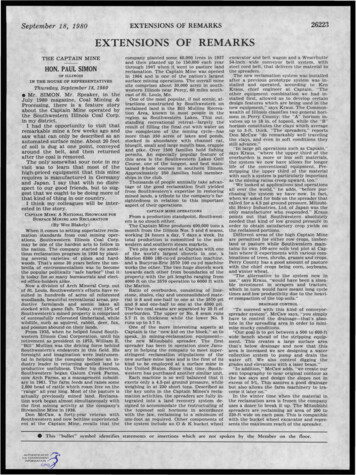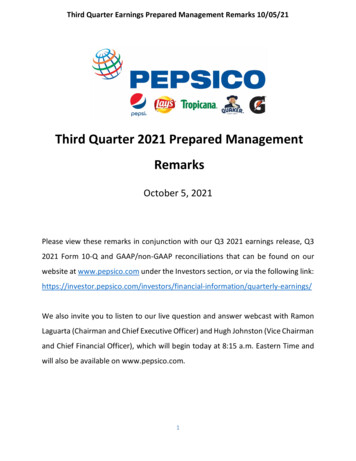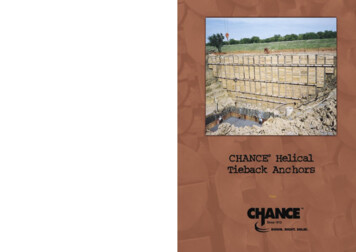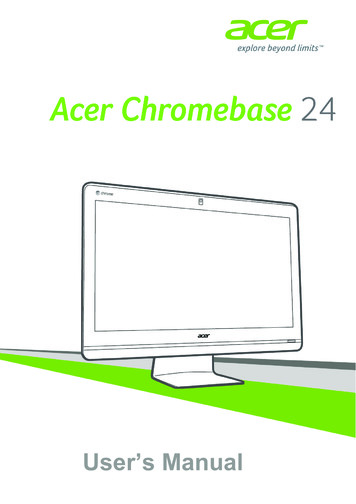
Transcription
September 18, 198026223EXTENSIONS OF REMARKSEXTENSIONS OF REMARKSTHE CAPTAIN MINEHON. PAUL SIMONOF ILLINOISIN THE HOUSE OF REPRESENTATIVESThursday, September 18, 1980e Mr. SIMON. Mr. Speaker, in theJuly 1980 magazine, Coal Mining &Processing, there is a feature storyabout the Captain Mine operated bythe Southwestern Illinois Coal Corp.in my district.I had the opportunity to visit thatremarkable mine a few weeks ago andsaw what can only be described as anautomated surface mine. About 20 feetof soil is dug at one point, conveyedaround the belt, and then returnedafter the coal is removed.The only somewhat sour note in myvisit was to learn that most of thehigh-priced equipment that this minerequires is manufactured in Germanyand Japan. I say that with no disrespect to our good friends, but to suggest that we ought to be doing more ofthat kind of thing in our country.I think my colleagues will be interested in the story.CAPTAIN MINE: A NATIONAL SHOWCASE FORSURFACE MINING AND RECLAMATION By Wes Blakely When it comes to setting superlative reclamation standards from coal mining operations, Southwestern Illinois Coal Corp.may be one of the hardest acts to follow inthe nation. The company started its ambitious reclamation program in 1936 by planting several varieties of pines and hardwoods. That's some 30 years before the umbrella of environmentalism was to becomethe popular politically "safe harbor" that itis today for so many bureaucrats and elected office-holders alike.Now a division of Arch Mineral Corp. outof St. Louis, Southwestern's efforts have resulted in hundreds of acres of reforestedwoodlands, beautiful recreational areas, productive farmlands and scenic lakes allstocked with game fish. Today, over 15% ofSouthwestern's mined property is comprisedof successfully reforested timberland, whilewildlife, such as squirrel, rabbit, deer, fox,and possum abound on their lands.From 1935, when he helped found Southwestern Illinois Coal Corporation, until hisretirement as president in 1973, William E."Bill" Mullins was the driving force behindSouthwestern's endeavors in this field. Hisforesight and imagination were instrumental in helping the company become an industry leader in returning spoiled land toproductive usefulness. Under his direction,Southwestern began Galum Creek Farms,now Arch Farms, as a management subsidiary in 1961. The farm feeds and raises some2,800 head of cattle which roam free on the" range" all year long. Most of the pasture isactually previously mined land. Reclamation work began almost simultaneously withthe first mining activity at the company'sStreamline Mine in 1936.Don McCaw, a forty-year veteran withSouthwestern and now beltline superintendent at the Captain Mine, recalls that theecompany planted some 40,000 trees in 1937and then planted up to 150,000 each yearthrough 1947 when it went to pasture landreclamation. The Captain Mine was openedin 1964 and is one of the nation's largestsurface mining operations. The overall minesite comprises about 30,000 acres in southwestern Illinois near Percy, 60 miles southeast of St. Louis, Mo.One of the most popular, if not scenic, attractions constructed by Southwestern onreclaimed land is the Bill Mullins Recreation Area, known to most people in theregion as Southwestern Lakes. This outstanding recreational retreat-largely theresult of filling the final cut with water onthe completion of the mining cycle-hasmore than 350 acres of lakes and ponds,stocked in abundance with channel cat,bluegill, small and large mouth bass, crappieand pike. Over 1500 families hold fishingpermits. An especially popular feature ofthis area is the Southwestern Lakes GolfCourse, one of the longest, and best maintained 9-hole courses in southern Illinois.Approximately 250 families hold memberships in the club.Thousands of people annually take advantage of the good reclamation fruit yieldedfrom Southwestern's expertise in restoringmined lands, a tribute to the company's farsightedness in relation to this importantaspect of their operations.CAPTAIN MINE OPERATIONSFrom a production standpoint, Southwestern is no slouch either.The Captain Mine produces 400,000 tons amonth from the Illinois Nos. 5 and 6 seams,working 24 hours a day, 7 days a week. Itstotal production is committed to the midwestern and southern steam markets.Two pits are operated at Captain with oneof the world's largest shovels in one, aMarion 6360 180-cu-yd production machine,and a Bucyrus-Erie 2570 100 cu-yd machineworks the other. The two huge shovels worktowards each other from boundaries of theproperty with the pit lengths ranging from4000 ft on the 2570 operation to 6000 ft withthe Marion.Ratio of overburden, consisting of limestone, shales, clay and unconsolidated material is 8 and one-half to one at the 2570 pitand 9 and one-half to one at the 6360 pit.The two coal seams are separated by 25 ft ofoverburden. The upper or No. 6 seam runs5.7 ft in thickness while the lower No. 5runs up to 3.7 ft.One of the more interesting aspects atCaptain is the "new kid on the block," so tospeak, in mining-reclamation equipmentthe new Mitsubishi spreader. The firstspreader has been in operation since January in helping the company to meet superstringent reclamation stipulations of thenew surface mine laws and is the first of itskind to be employed at a surface mine inthe United States. Since that time, Southwestern has purchased another similar unit.Each machine is so well balanced that itexerts only a 4.5-psi ground pressure, whileweighing in at 230 short tons. Described asthe key units in the Captain Mines's reclamation activities, the spreaders are fully integrated into a land recovery system designed to accommodate the restructuring ofthe topmost soil horizons in accordancewith the law, reclaiming to a minimum ofone-foot as required. Other components ofthe system include an 0 & K bucket wheelexcavator and belt wagon and a Weserhutte54-inch wide conveyor belt system, withsteel cord belt, that delivers the material tothe spreaders.The new reclamation system was installedafter a previous prototype system was installed and operated, according to KenKraus, chief engineer at Captain. "Theother equipment combination we had installed first, allowed us to develop certaindesign features which are being used in thenew equipment," says Kraus. The Commonwealth of Illinois classifies two general horizons in Perry County: the " A" horizon involves up to 18 in. of topsoil, while the "B"horizon constitutes the clays which averageup to 3-ft. thick. " The spreaders," reportsDon Mccaw " do remarkably well travelingthe clays, and even in soft conditions theystill advance. ""In large pit operations such as Captain, "says Kraus, "where the upper third of theoverburden is more or less soft materials,the system we now have allows for longerlife of the conventional equipment. Prestripping the upper third of the materialwith such a system is particularly importantas the mining ratios creep upward, too. ""We looked at applications and operationsall over the world," he adds, " before purchasing the system we have now. In fact,when we asked for bids on the spreader thatcalled for a 4.5 psi ground pressure, Mitsubishi Heavy Industries, Ltd. of Japan was theonly manufacturer who responded." Krauspoints out that Southwestern absolutelyneeded that kind of low ground pressure inorder to obtain satisfactory crop yields onthe reclaimed portions.Different areas of the high Captain Mineare permitted for either row crops, timberland or pasture while Southwestern maintains its own 100-acre soils test plot at Captain where it experiments with various combinations of trees, shrubs, grasses and crops.Perry County has a good amount of pasturewith the chief crops being corn, soybeans,and winter wheat."The alternative to the system now inuse," says Kraus, " would have been a sizeable investment in scrapers and tractors,which in turn would have meant long cycletimes and low productivity due to the heavier compaction of the top soils."DRAINAGE CONTROL"To succeed with this kind of conveyorspreader system", Mccaw says, " you simplyhave to control the drainage-that's absolute in the spreading area in order to minimize mucky conditions." Our goal is to get between a 500 to 600-ftwide bench ahead of the stripping equipment. This creates a large surface areathat's below drainage and now that thisarea is increased we are designing a watercollection system to pump and drain thewater off. We also control digging thegrades and elevations with a laser beam."" In addition," Mccaw adds, " we create ourown topography to near original contour asthe law says and design the slopes not inexcess of 5%. This assures a good drainagebut also allows the farm machinery to traverse it later on."In the winter time when the material inthe reclamation area is frozen the companyuses a dozer to break it up. The Mitsubishispreaders are reclaiming an area of 200 to220-ft wide on each pass. This is compatiblewith the bucket wheel excavator and represents the maximum reach of the spreader.This "bullet" symbol identifies statements or insertions which are not spoken by the Member on the floor.
26224"Of course," McCaw says, "our operatorswith the system are improving each day asthey get more comfortable in handling theequipment. As the operators gain experience, we'll see an improvement, I'm sure, inour moving times, too. This is as critical tous as the time involved underground withmoving a longwall mining system."At the same time, even Southwestern'snearly 45 years of experience in reclaimingmined lands is being put to the severest oftests today as a result of the stringent newlaws-as is all of the nation's surface coalmine operations for that matter. Thismeans the environmentally vital role of thespreader in restoring soils for eventual grading and planting will undoubtedly grow inimportance. As Ken Kraus puts it, "I cansee where these machines can be an integralpart of surface mine operations not only inthe midwest but in such areas as the Texaslignite fields, too."eEXTENSIONS OF REMARKSThe entire Fountain Hill communityowes much to this dedicated group ofvolunteers. As their Congressman, Isalute them for making their community a better, safer community inwhich to live and grow.eSeptember 18, 1980REAGAN IS RIGHT ON THEHOSTAGESHON. LARRY WINN, JR.OF KANSASIN THE HOUSE OF REPRESENTATIVESThursday, September 18, 1980BLOOD ALLEYHON. W. J. (BILLY) TAUZINOF LOUISIANAIN THE HOUSE OF REPRESENTATIVESThursday, September 18, 1980e Mr. TAUZIN. Mr. Speaker, I am introducing legislation to help resolveone of the most serious situations inhighway safety in our country. A 30mile section of U.S. Highway 90,stretching between Morgan City, La.,A DEDICATED GROUPand Gray, La., has become infamouslyknown as Blood Alley, claiming 50lives and causing 1,263 injuries beHON. DON RITTERtween 1974-78. Planning for a new,OF PENNSYLVANIAmore direct, and safer route betweenIN THE HOUSE OF REPRESENTATIVESMorgan City and the intersection ofThursday, September 18, 1980Louisiana Highway 311 began in 1972,e Mr. RITTER. Mr. Speaker, volun- but due to bureaucratic delays, theteer firemen are dedicated people, project remains incomplete. At thisserving their communities with deeppride. They are available at a mo- time, no Federal funds are involved inment's notice-day or night-whenever the project and the environmentalan alarm sounds. Risk and danger do questions have long since been annot enter their minds as they come to swered.Originally planned by the FHW A inthe aid of their fell ow man.Typical of this group is the Fountain 1972 using Federal funds, the projectHill Hose Company, which will mark was abandoned before constructionthe 75th anniversary of its founding at began. No further action was takenuntil August 4, 1977, when a bridgea public celebration on October 10.This volunteer fire company has permit application was submitted byplayed a vital role in its community of the State to the 8th Coast Guard Dis4,000 residents in Lehigh County. It trict to construct the highway usinghas not been an easy road. There were State funds. The initial draft EIS wasmany struggles, especially in the early completed by the Coast Guard andyears, which predated the company's filed with EPA on May 26, 1978. Afterofficial founding.review of the DEIS, strong objectionsThirteen men signed up on the night were voiced by the EPA, U.S. Fish andof July 30, 1894, when the borough fa- Wildlife Service, and the Corps of Enthers organized a fire department. gineers to the proposed highway alineWithin a year, the volunteers had dou- ment because of its adverse impact onbled. A barn was rented for 3 a the existing wetlands. As a result, almonth to store hose and a hose cart.ternative routings were examined forThe evolution was slow. Fire plugs over 1 year. In the interim, other spewere installed when the borough's cialized studies had to be conductedwater system came into being in 1894. because of new laws and regulations orFour push-button alarm boxes were because of the realinement or both. Inadded in 1901. Application was made November 1979, the EPA, U.S. Fishin October 1905 for a charter. A new and Wildlife Service, and the Statefirehouse was completed in 1911, the agreed upon a new routing alinementalarm system updated and a rebuilt that satisfied previous objections. · Asteam engine purchased for 2,300. In rewrite of the DEIS was required by1920, a fund drive raised 12,000 to the U.S. Coast Guard, for which thepurchase a triple combination truck.Several used trucks were purchased State has hired a contractor to comthrough the years and used until 1977 plete.With no major objections to the prowhen a fund drive raised 60,000toward the purchase of a new Mack posed project by any agency involved,only bureaucratic delays stand in thepumper.Today, Chief James Bobal heads a way of mitigating this hazardous,group of 20 firefighters. In addition, urgent situation.I urge the House to take action onthere are 450 social members and aladies auxiliary which assists in var- this critical matter at the earliest posious fundraising efforts.sible date.e Mr. WINN. Mr. Speaker, GovernorReagan has shown great decisiveness,sensitivity, and competence in his comments on the Ayatollah Khomeini'slatest statement on the American hostages.The Republican Presidential candidate has stated simply and forthrightly that the United States should agreeto cancel American claims againstIran, release Iran's frozen assets, andpromise not to intervene in its internalaffairs in exchange for the release ofthe hostages. The ayatollah's fourthdemand-the return of the shah'sproperty-is not, as Governor Reaganstated, in U.S. Government hands.The Washington Post, in its lead editorial of September 15, recognized theimportance of Ronald Reagan's statement. I recommend it to my colleagues:GOVERNOR REAGAN ON THE HOSTAGESGovernor Reagan said the right thingabout the hostages. Responding to Ayatollah Khomeini's latest set of demands, themselves seemingly pared down from an earlierand longer list, the Republican presidentialcandidate said the United States shouldsimply agree to most of them. It shouldcancel American claims against Iran, releaseIran's frozen assets and promise not to intervene in its internal affairs. The onlyKhomeini demand Mr. Reagan set aside wasone for return of the former shah's property; that, he explained, is not in the U.S. government's hands. He recommended agreeingto do all of this, moreover, right off: not toengage in a long negotiation about it butjust to agree to the three Khomeini demands and then to insist that the 52 American hostages be returned at once. Be donewith it.It is possible that Mr. Reagan will now becharged at home with barging in and yielding too much too soon. The answer, it seemsto us, is that he is not negotiating in thefirst instance with Tehran; Jimmy Carter is.Gov. Reagan is in the first instance addressing Jimmy Carter. He is freeing the administration of the anxieties it has felt that Mr.Reagan would hover on the right, threatening to undercut any Carter effort to negotiate the hostages' return. Mr. Reagan wouldnow seem to have left the president plentyof room over the next few months to continue his policy of cautiously but energeticallyexploring Iran's terms.This is not to say the Reagan initiativehas no political dimension. It will probablystrike many Americans as an example offair-minded, no-nonsense, presidential decisiveness-a quality that Mr. Carter has hadfull opportunity to show in the WhiteHouse. But the Reagan response does morethan that. A large part of Mr. Carter's reelection strategy has been to suggest that,on foreign policy in particular, Gov. Reaganis an unlettered, ineducable primitive, capable for political cause of savaging necessarily sensitive diplomatic affairs. On the Iranissue at least, that particular campaignstrategy now may be frustrated.
September 18, 1980As to whether the Reagan approachwould work if it were to become officialpolicy, only a test could tell. There is a realquestion whether the new Khomeini demands represent either his final formulation or that of the Iranian parliament or ofthe particular terrorists holding the Americans. A case can be made, however, thatthere is a point beyond which it is self-defeating to wait until everything shakesdown on the Iranian side. That could takeforever. The Americans have already beencaptive nearly a year. It is at least conceivable that a clear, clean American position,forthrightly stated, could make its own contribution to untying the political knots thatbind the hostages still.Notably lacking from the ayatollah'slatest set of conditions on the releaseof the hostages and from GovernorReagan's statements is any hint of anyU.S. apology to Iran over past American misdeeds in that country.This contrasts sharply with recentstatements by the Department ofState spokesman regarding the possibility of a U.S. apology to Iran.In a September 10, 1980, briefing tothe press, the State Departmentspokesman refused to rule out a U.S.apology to Iran. Furthermore, whenasked if the Department were prepared to discuss the question of apologies, he stated:I think we're prepared to discuss anythingand everything. I wouldn't want to give youto think that we would end up agreeing todo so; but I think we're ready to discuss, asthe Secretary's letter says, anything thatthe Iranians want to discuss.Our prime objective is to get the hostagessafely released; and, in the context of that,there are a lot of things that can be discussed and that can be done. I think we'veenunciated some of those before.I am shocked by this statement andam opposed to any U.S. apology toIran or willingness to discuss Iraniangrievances against the United States.Indeed, I trust that the followingpassage from Secretary of StateEdmund Muskie's August 20 letter tothe Iranian Prime Minister Rajai doesnot suggest a U.S. apology to Iran:We also recognize that in Iran, as in theUnited States, there are deep feelings as aresult of grievances perceived in the past.There are many difficult issues between theUnited States and Iran. For our part, we arewilling to proceed fairly and to approacheach of these issues on a basis of mutual respect and equality.Secretary of State Muskie's letterwas supplied to the Subcommittee onEurope and the Middle East. It has, ofcourse, subsequently been released tothe press.As one of the 187 Members of Congress who sent a letter on July 2, 1980,to the Speaker of the newly formedIranian Parliament urging him to givethe hostage issue "your highest andearliest priority," I would support adialog between the United States andIran. However, this dialog must be onan honorable basis. Its objective mustnot be the humiliation of the UnitedStates through demands for apologiesor incantations of grievances againstthis country.eCX:X:VI--1649-Part 20EXTENSIONS OF REMARKS26225SOUTH KOREAN REGIMEPASSING POINT OF NO RETURNAnyone caught doing this kind of thing ina communist country would be punishedwith death.In the United States a group is doing itand getting away with it.An outfit that calls its periodical theCovert Action Information Bulletin published, on Wednesday, the names and somebiographical details on what it described as40 Central Intelligence Agency officers andagents operating in 31 countries.The list purportedly named 13 chiefs ofstation, eight deputy chiefs and 19 senior"case officers," officers who supervise localagents. One of the deputy chiefs working ina foreign assignment was identified as awoman.Among those named were CIA personnelsaid to be operating in such potentially dangerous posts as Algeria, Guatemala, Jerusalem, Libya and Zaire.The periodical remarked that legislation ispending in Congress to make a criminal offense of the unauthorized identification ofintelligence personnel.It stated that it would continue to do soeven if the practice were outlawed."We do not believe that it can be constitutionally suppressed by the government," itstated. "If any of the proposed laws designed to censor this column out of existence are passed we can assure our readersthat we will fight them in the courts."Perhaps in some courts this twisted anddegraded conspiracy will find sympathy.Much of the United States anti-espionageapparatus was dismantled by ill-conceivedand misguided court decisions during thelate 1950s.Considering the peril and difficultiesfaced constantly by many U.S. intelligenceagents overseas, disclosing their identitiesand posts is comparable to giving an enemydefense al\d troop movement secrets in wartime. It is treacherous and potentiallydeadly. Those guilty of such misdeeds shouldbe punished.The authors of the bulletin state theirobject to be the destruction of American intelligence agencies. It is a purpose which coincides with those of the KGB, GRU andother hostile and dangerous espionage andassassination forces.If those responsible for the bulletin meantto wage a campaign in behalf of the friendsof freedom instead of the enemies of freedom, they would disclose the identities oftotalitarian secret agents operating in theUnited States.eHON. JOHN EDWARD PORTEROF ILLINOISIN THE HOUSE OF REPRESENTATIVESThursday, September 18, 1980 Mr. PORTER. Mr. Speaker, yesterday a South Korean military courtsentenced Kim Dae Jung to death. Hiscrime? Leading the opposition to thepresent military regime and allegedlyplotting to overthrow by violence aregime itself founded upon the violentoverthrow of its predecessor.For 35 years the United States hassupported South Korea, not only withour national treasure but with thelives of over 30,000 American GI's. Ourintent was not altruistic but to establish a nation to show the people inthat part of the world that our systemof democrary can make a better lifefor all. Yet in those 35 years scant evidences of democracy in South Koreahave been observed.Clearly, with North Korea bellicoselybreathing down its neck, the SouthKorean situation is difficult. Clearly,the liberties we want assured would allbe lost if the Communist North gainscontrol.But clearly, too, if the South hasbecome the North in its failure to observe the basic tenets of due processand justice under law for all its people,our support has been misplaced andour American lives lost in vain.This sham trial and the continuedtrampling of the democratic processesand basic rights by the military regimein South Korea is intolerable and hasplaced further support for that country by ours in extreme jeopardy.Kim's execution would pass thepoint of no return.eSNITCHING ON CIAHON. EDWARD J. DERWINSKIOF ILLINOISIN THE HOUSE OF REPRESENTATIVESThursday, September 18, 1980e Mr. DERWINSKI. Mr. Speaker, theHouse of Representatives is scheduledto take up the Intelligence IdentitiesProtection Act in a few days. The billwas reported out of the House Permanent Select Committee on Intelligenceunanimously, and the Committee onthe Judiciary with a wide margin. Ihave received press comment on thebill from widely separated areas of thecountry. Here is a favorable editorialin the Indianapolis Star of June 1,1980, written before the July 4 attackon the home of the CIA station chiefin Jamaica:SNITCHING ON CIAWhat some call snitching and some callratting is making life tough for Americanspies in assignments that are dangerousenough without such treachery.Too many American agents overseas havebeen assassinated. Marking them-disclosing their names-smacks of treason.AVIATION FUEL TAXAMENDMENTHON. ROBERT DUNCANOF OREGONIN THE HOUSE OF REPRESENTATIVESThursday, September 18, 1980e Mr. DUNCAN of Oregon. Mr.Speaker, the bill my distinguished colleague, the chairman of the Ways andMeans Committee, Al Ullman, and Iintroduce today corrects a gross injustice in the aviation fuel excise tax, therevenues of which currently flow intothe Airport and Airway Trust Fund 49 U.S.C. 1742, et seq.).Congress established the Airportand Airway Trust Fund in 1970 tomeet the financial obligations of theFederal A via ti on Administration andthe Department of Transportation intheir statutorily required activities ofplanning, research and development,
26226EXTENSIONS OF REMARKSconstruction, or operation and mainte- environmental groups have, withoutnance of: (i) air traffic control, ii) air exception, resulted in enthusiaticnavigation, (iii) communications, [and] praise for the results.In addition . most of the businesses iv) supporting services, and for theadministrative expenses connected engaged in aerial logging, harvestingwith these activities 49 U.S.C. 1742 (f) and cultivation are small and lack theresources of major lumber companies.(1) AHC)).In creating the trust fund, Congress For this reason, they operate on muchgave statutory form to a very simple smaller budgets, and unnecessary exprecept: that those who use our air- penses damage the businesses themports and airways systems and facili- selves and their future expansion andties ought to bear a fair share in the development, and the refinement ofexpenses incurred in their operation. this type of timber harvesting. TheTo this end, we levied an excise tax on excise taxes paid annually into theaviation fuel used in noncommercial trust fund for the upkeep of airportsaviation (26 U.S.C. 4041 (c) and (d)). and airway systems that these busiFor aircraft using the airports and air- nesses do not use, represent just suchways and enjoying the air traffic con- an expense and should be eliminated iftrol and support services of the FAA we are to encourage the most judiciousand DOT, this makes plain common- use of our national timber resources.sense. In fact, in 1970 when we en- Whenever these aircraft use the airacted the legislation, specific report ports and airways facilities theyshould, and under this amendmentlanguage provided that: there will be a direct relationship be- would, pay the tax.But because of our national interesttween the use of the system and the moneygenerated to meet the needs required by the in increasing the allowable cut withusers. It is fitting that the primary financial out impairing the environmental qualburden will be assumed by the direct users ity of the land; because in this activi . H. Rept. 91-601, 91st Congress, 2d ses- ty, aerial loggers are not users of thesion 0970).airports or airways facilities; and beEarly on, however, it became clear cause of the economic importance ofthat certain types of noncommercial this small business enterprise to theaviation-agricultural aviation in par- employment picture of the Northwestticular-did not utilize the benefits of and the Nation, this amendment tothe airports and airways and, in a,ll the aviation fuel excise tax that wefairness, should be exempted from the propose today is fair, equitable andexcise tax (26 U.S.C. 4041 0).wholly in keeping with the intent ofThe bill we introduce today creates Congress in allocating the financialan analogous exemption from the burden of operating airports and airexcise tax for those aircraft used in ways to those who use them.etimber cultivation and harvesting, andthe prevention and fighting of forestfires.Like agricultural aviation, aerial log- TRIBUTE TO CONGRESSMAN WILLIAM S. MOORHEAD OF PENNging and timber cultivation require noSYLVANIAuse of this country's airport andairway system. They do, however, provide an economical and necessaryHON. DANTE B. FASCELLmeans of timber production and addOF FLORIDAimmeasurably to the health of theIN THE HOUSE OF REPRESENTATIVESeconomy of the country, and particuTuesday, September 16, 1980larly to the Pacific Northwest. Theyalso allow the timber industry and en- e Mr. FASCELL. Mr. Speaker, I amvironmentalists with a means of strik- very grateful to our colleagues froming a balance acceptable to both. If we Pennsylvania, Mr. GAYDOS and Mr.are to provide adequate housing and MCDADE, for this opportunity to thankwoods products for our citizens and BILL MOORHEAD formally for his effecfuture generations, it is imperative tive service in the House and to wishthat we increase the allowable cut. Si- him well as he returns to private life.multaneously, environmentalists exert We have been extremely fortunate,heavy pressure to restrict the harvest- both as a Congress and as a nation, toing of timber so as not to damage our have a man of BILL'S ability as a legisforests and drainage systems.lator for these past 22 years. It is hisAerial logging offers an opportunity, turn, now, to enjoy his family andalready tried, tested and proven prac- pursue his many interests, and our sintical, to satisfy both of these national cere good wishes go with him as he reobjectives. With proven economic feas- tires.ibility, the harvesting of timber andIt has been a pleasure for me toforest products by aircraft eliminates serve on the Committee on Governthe erosion problem caused by road ment Operations with BILL. We shareconstruction and by the scarifying of a great interest in the issues t
september 18, 1980 extensions of remarks 26223 extensions of remarks the captain mine hon. paul simon of illinois in the house of representatives thursday, september 18, 1980










